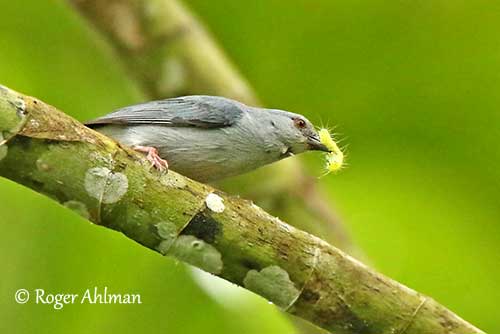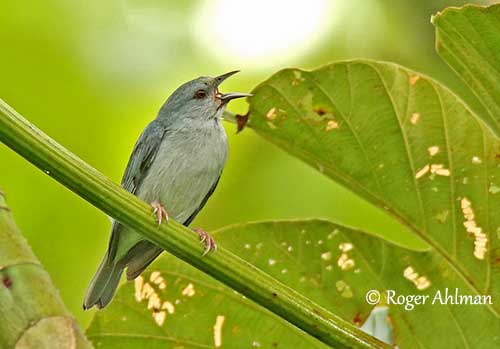
Fr: Conirostre marguerite
Ang: Pearly-breasted Conebill
All: Perlbrust-Spitzschnabel
Esp: Conirrostro Pechigrís
Ita: Conibecco pettoperla
Nd: Parelborstspitssnavel
Sd: pärlemorkägelnäbb
Photographers:
Roger Ahlman
Pbase Galleries Peru and Ecuador
Ken Havard
My Bird Gallery & Flickr gallery 1 & Flickr gallery 2
Text by Nicole Bouglouan
Sources:
HANDBOOK OF THE BIRDS OF THE WORLD Vol 16 by Josep del Hoyo- Andrew Elliot-David Christie – Lynx Edicions – ISBN: 9788496553781
BIRDS OF PERU by Thomas S. Schulenberg, Douglas F. Stotz, Daniel F. Lane, John P. O’Neill, Theodore A. Parker III – Princeton University Press 2007-ISBN: 978-0-691-13023-1
BIRDS OF SOUTH AMERICA – Passerines - by Robert S. Ridgely and Guy Tudor – HELM Field Guides – ISBN: 9781408113424
Neotropical Birds – Cornell Lab of Ornithology
Pearly-breasted Conebill
Conirostrum margaritae
Passeriformes Order – Thraupidae Family
INTRODUCTION:
The Pearly-breasted Conebill is a rare bird limited to river islands where it frequents woodlands of mature Cecropia trees. It is patchily distributed along the Amazon River and some of its largest tributaries. It is often found in pairs moving through the canopy, and in small family groups after the nesting period.
The Pearly-breasted Conebill is threatened by deforestation and currently listed as Vulnerable.
DESCRIPTION OF THE BIRD:
Biometrics:
Length: 11-12 cm
The Pearly-breasted Conebill has pale bluish grey crown, nape and upperparts, including wing-coverts and tail. The primary flight-feathers are darker with narrow grey edges, whereas secondaries and tertials show broad pale grey edges.
Chin, throat and underparts are pale grey, with mostly whitish to greyish-white belly and vent.
The face is pale grey.
The sharply pointed bill is dark grey. The eyes are pale brown to dull pinkish brown. Legs and feet are pinkish or pale pinkish-brown.
Male and female are similar.
The juvenile is olive above and yellowish below, with olive wash on flanks.

RANGE:
The Pearly-breasted Conebill is patchily distributed in South America. It is found in NE Peru on the banks of lower R Napo, and banks of R Amazon near Iquitos, and also E in Brazil to vicinity of R Jamundá. There is an isolated population near the junction of R Beni and R Iténez and in N Bolivia near the junction of R Madre de Dios, Beni and Mamoré.
HABITAT:
The Pearly-breasted Conebill frequents the canopy of Cecropia woodlands on river islands, especially on the Amazon River and its largest tributaries.
However, this species is often erratic due to the ephemeral nature of its habitat, and appears to be able to colonize new areas as soon as they become suitable.
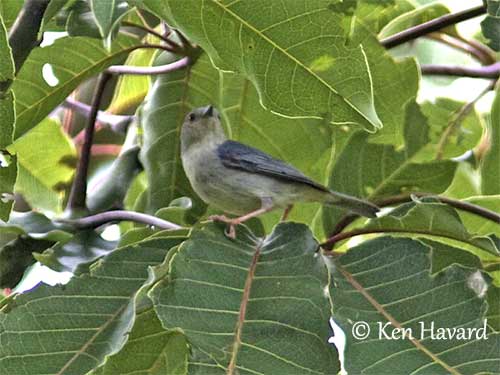
CALLS AND SONGS: SOUNDS BY XENO-CANTO
The Pearly-breasted Conebill gives a high « teep » and « ti-ti-ti » and we can also hear a sharp “tip-tseep”.
The song is a jumbled series of musical notes with squeaky warbles and sharp “chip” notes. The loose phrases are often given as duets by both mates.
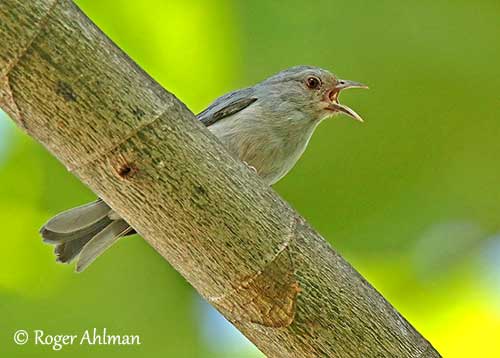
BEHAVIOUR IN THE WILD:
The Pearly-breasted Conebill feeds probably on small arthropods and Cecropia seeds.
It forages in the foliage in canopy of Cecropia trees. It works rapidly, picking at leaves for small insects. It may also hang upside down to reach some food items. It also gets prey from the bark of the trees, and may occasionally feed on seeds of Cecropia.
The Pearly-breasted Conebill appears to be socially monogamous and highly territorial.
Few breeding information is available on Thraupidae from this region.
This species performs some movements to new suitable habitats, and disperse quickly to new river-islands sites. The populations seem to be highly mobile.
It is a good flier and the flight is fast.
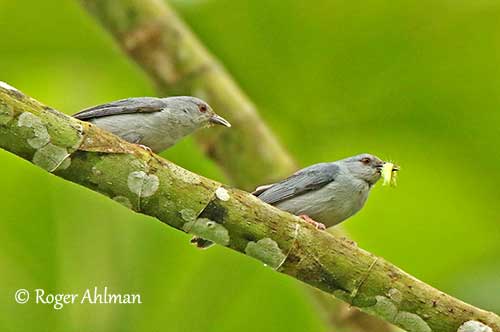
REPRODUCTION OF THIS SPECIES:
Information on breeding and nesting behaviours is currently lacking. The breeding season occurs in September through October for numerous South American species.
PROTECTION / THREATS / STATUS:
The Pearly-breasted Conebill is patchily distributed throughout its restricted range. However, it is able to adapt to new habitats when necessary, due to the short-lived successional vegetation growing through the seasonal flooding.
The species is threatened by deforestation. It is uncommon and local, and the population is suspected to be declining.
The Pearly-breasted Conebill is currently listed as Vulnerable.
